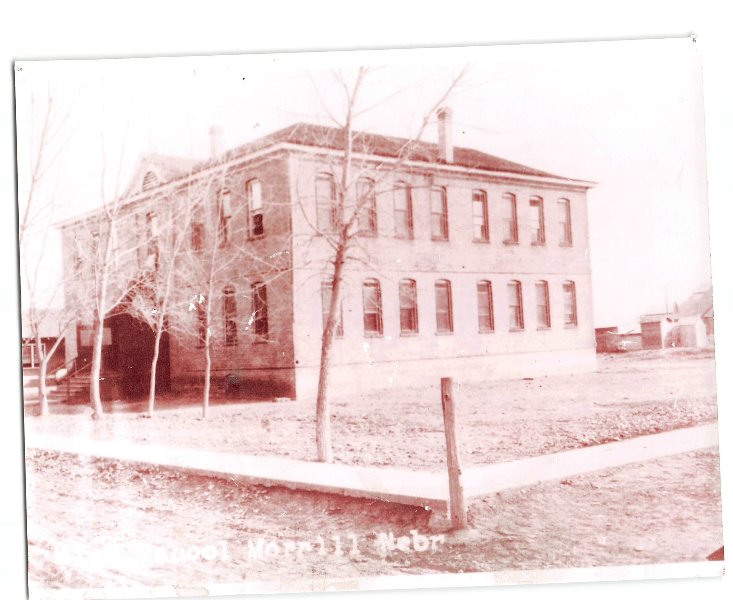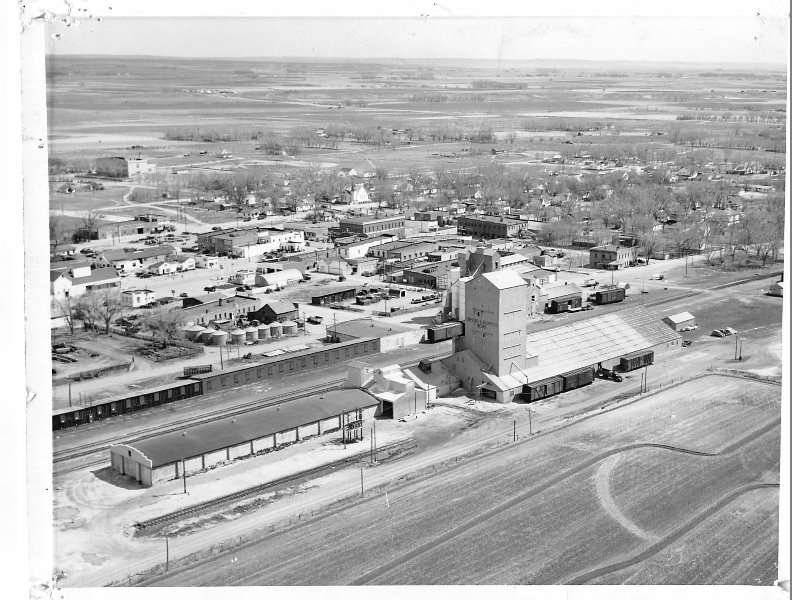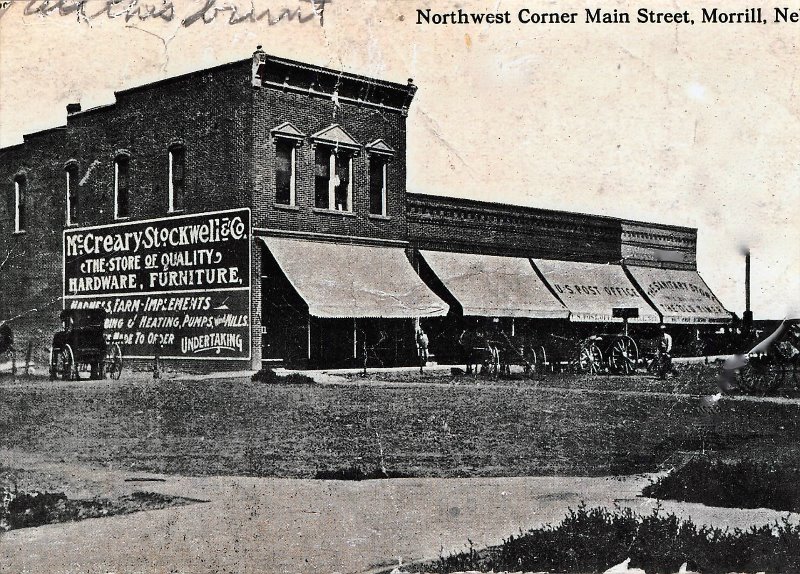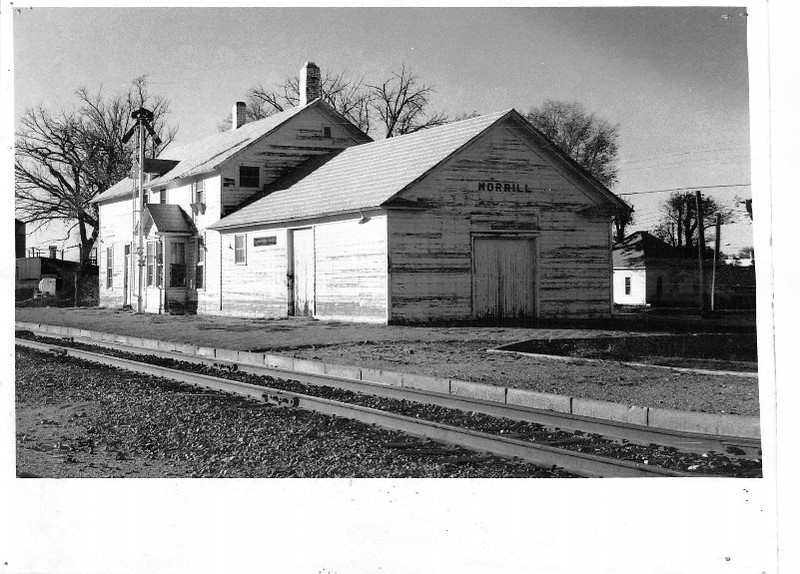History
The Village of Morrill is located in the extreme west Panhandle of Nebraska. It is a small community with excellent schools, businesses and pride in community development.
It all started in 1886 when the first settlers, W.R. Ackers, C.W. Ford, J. Richards and J.C. Weeks found a fertile valley at the mouth of the Sheep Creek draw and staked their claims. They had come from Fort Collins, Colorado in search of a new home. They called their new home Collins, in remembrance of their previous home. Collins was just seven-tenths of a mile north of the present Morrill town site. In 1889, as new settlers joined the community, they built a school, a sod building to accommodate the 18 students, children of the settlers. The first teacher, Cora Akers, was paid with contributions. A Post Office was established at Collins on January 2, 1889 with J.C. Weeks as Postmaster.
It became apparent after several summers of drought that farming could not be successful unless irrigation of some kind could be established. So some of the settlers, with only shovels, a team of horses and a slip, dredged out an irrigation canal eight miles long that brought water to this little valley at the mouth of Sheep Creek draw. Later the Tri-State Canal was built along this ditch line.
The railroad which made its appearance in this area in 1900 determined the relocation of this settlement to what is now Morrill. The Burlington built a "Y" track at Morrill. A train would arrive at noon from Bridgeport with mail and passengers and then turn around and go back. Prospective homesteaders would come this far on the train. They could rent a team and a hack from an enterprising liveryman for $1.50 so they could scot the area for a homestead site. The community continued to thrive.
The town was named for Charles Henry Morrill who was president of the Lincoln Land Company and as president laid out a tract of land for a town when he heard the the Burlington was planning to have a depot and agent in the area.
The Post Office at Collins was discontinued May 29, 1889. It was not until 1901 that a Post Office was opening in Morrill on December 26 in a store known as the "Gaines" store. A new frame school house had been built in 1900 to replace the original sod school.
Morrill experienced a building boom in 1905 as a result of the building of the irrigation canals. A boarding house was built by George Jenkensons to accommodate the canal builders, the Abts brothers opened a blacksmith and harness shop and Ed Sayre opened a mercantile store.
The Village of Morrill was incorporated in April of 1907. Some of the original building as still occupied today with businesses.
Electricity came to Morrill around 1912. Adam Abts provided the electricity by a generator run by a big semi-diesel. Electricity was on from 4:00 p.m. to 10:00 p.m.
The Methodists dedicated their first building May 3, 1908 with $711.00 of the $4,000.00 donated by the ladies aid from a bazaar that lasted three days. The Presbyterians dedicated their first church in 1910. Frank Warner built the cement blocks for this first church.
Some time between 1905 and 1907 a second room was added to the little frame school house. In 1908 the third school. a two story brick building was erected two blocks east of main street on what is now Highway 26. It housed both elementary and high school grades until 1919 when the fourth school was erected two blocks east of main street and three blocks north of the center of town. In 1959 a new high school was built. in 1980 it became necessary to build a new elementary school building to comply with state codes and to meet increasing enrollments.
In the 1920's potatoes had become a successful cash crop and Morrill became known as an important shipping point. Among the early potato buyers were Paul Covington, Gene Bellingar, Stanley Albertson, Burt Israel and Vint and Roy Garrett. In 1923 Chester B. Brown harvested his first 10 acres of beans and was convinced that beans could be an alternate crop to potatoes and sugar beets. In 1927 Brown rented the potato warehouse and started commercially handling dry beans. The business is now owned by Kelley Bean, which is owned and operated by the sons of Robert L. Kelley, who come to work for Brown in 1929. John R. Jirdon enterprises began as a partnership with W. R. Preston in 1915 in a lumber yard and feed store business. In 1923 they sold the lumber yard and John R. Jirdon took over the grain and feed business as sole proprietor. The business expanded to include flour, hay, feed, seed, livestock and many other things that provided a ready cash market for the stock growers and farmers and other agricultural activities.
Cargill bought a portion of Jirdon Industries in June of 1985. An off shoot of the Jirdon Industries is the Jirdon Agri Chemical Company which handled fertilizers and agricultural chemicals and seeds.



 Launch the media gallery 1 player - media #1
Launch the media gallery 1 player - media #1 Launch the media gallery 1 player - media #2
Launch the media gallery 1 player - media #2 Launch the media gallery 1 player - media #3
Launch the media gallery 1 player - media #3 Launch the media gallery 1 player - media #4
Launch the media gallery 1 player - media #4 Launch the media gallery 1 player - media #5
Launch the media gallery 1 player - media #5